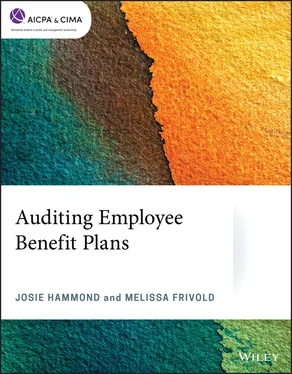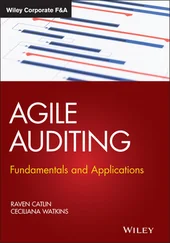1 ...6 7 8 10 11 12 ...21 As noted earlier, the operation of a benefit plan is substantially controlled by the tax code. Thus, the auditor is advised to have a working understanding of these elements. Most of the rules for pension plans are found in Sections 401 through 416 of the IRC. Welfare benefit plans have fewer code rules, and those rules are scattered throughout the IRC.
GAAS does not require that the auditor have a thorough understanding of the intricacies of these tax rules. GAAS limits the auditor’s duty for compliance matters to those that could affect a significant financial statement account. It is important for the auditor to be able to identify the type of elements involved in the operation of the plan and where they might have financial statement effect. It is important for inquiries to be made as to whether the appropriate tests have been conducted and whether the tests have been passed or failed. Where such tests have been failed, the auditor needs to understand the effect on the plan’s financial statement. This may involve a contribution receivable or a payable to refund impermissible amounts. In addition, the auditor needs to be able to recognize that other items uncovered during the audit may have an effect on the tax status of the plan. Where such events are discovered, the auditor needs to assess the effect on the financial statements and obtain appropriate representations that any actions required to retain the plan’s exempt status will be taken.
The easiest way to understand these tax rules is to approach them from the formation through annual operations to termination of a plan.
Even though benefit plans are typically exempt from income taxes, it is important for the auditor to assess whether or not there are any uncertain tax positions. This is because the plan can face uncertainty with respect to retaining its tax-exempt status, or where the plan’s investment activity generates unrelated business income tax. This will be addressed in more detail in the discussion of unrelated business income tax in the following sections.
Any ERISA plan is required to be in writing. The written document is to include the rules governing the operation of the plan and the management of plan assets. A pension plan is permitted, but not required, to apply for determination by the IRS of its qualified status. Most individually designed plans do obtain such letters. When a plan uses an IRS preapproved plan document (such as a prototype plan), the plan may not have a separate letter. Rather, the sponsor may rely on the opinion or advisory letter issued to the preapproved plan document sponsor. Effective May 1, 2012, the IRS revised the determination letter program so that many adopters of master or prototype plans will be unable to obtain an individual determination letter. Further, effective January 1, 2017, the IRS has eliminated the determination letter program covering amendments to individually designed plans. Existing determination letters will no longer expire, and the plan sponsor is required to make amendments as required by changes in the law or plan designs. But, they may not be able to obtain a determination letter covering such amendments. The IRS has stated that it will issue determination letters upon request at plan formation and termination, as well as in other circumstances as it concludes to be appropriate. It is not yet clear what that latter category covers. Practitioners are hoping that it will cover significant changes in the governing law or regulations or possibly specific facts, such as before a merger. These changes do not affect the opinion letter program covering preapproved plans such as master, prototype, or volume submitter documents.
Historically, 403(b) plans involved a series of documents—board minutes, employee handbooks, annuity or investment contracts, and so on. However, the IRS final 403(b) regulations required all 403(b) plans to be documented more formally. A single written agreement is not required, but the plan document(s) must reflect all of the operating terms and conditions of the plan and must have been in place by December 31, 2009. The IRS has initiated a system for the pre-approval of prototype or volume submitter 403(b) documents. There is no program for the approval of individually designed 403(b) plans.
Under the IRS pre-approved 403(b) plan document program, March 31, 2020 is the last day for an employer to adopt a pre-approved 403(b) plan. After that date, adoption of a pre-approved 403(b) plan will no longer give an employer retroactive relief plan document-related qualification defects that arose since 2010.
Welfare plans have no formal approval process. However, where a welfare plan is funded through a voluntary employee’s beneficiary association (VEBA) Section 501(c)(9) trust, written request for tax-exempt status on the VEBA is mandatory for plans established after 1984.
The plan must specify eligibility rules. Pension plans have very specific minimum rules. No person can be required to be employed more than 12 months for eligibility (two years if the plan is fully vested). Minimum entry age cannot exceed 21. (The combination of these two rules can result in a wait longer than the minimum wait. An 18-year-old, for example, can be required to wait three years for entry.) These rules are to be included in the plan document.
For this purpose, a year has a specific definition. Generally, an employee has to work at least 1,000 hours for the year to count for eligibility purposes. However, many plans use the elapsed time method, which does not count hours worked only a calendar period of service.
These basic age and service rules define which employees must be considered for testing.
Plans can exclude persons for other reasons—location, job description, and so on. These exclusions may not violate other federal laws governing discrimination on account of age, sex, religious affiliation, and the like. These exclusions are treated as employees eligible to participate, but not receiving benefits for purposes of the plan’s satisfying the various discrimination requirements. Part-time status is not a permissible definition for exclusion from plan eligibility; the 1,000-hour rule described previously is the only basis for excluding persons because of the number of hours worked.
403(b) plans have slightly different eligibility standards for employee salary deferrals, which are to be documented in the plan. Few exclusions from eligibility are permitted for employee salary deferral contributions. The standards described previously are permissible with respect to employer contributions to a 403(b) plan.
Welfare plans do not currently have specific eligibility standards that are set by law. The plans, however, must define what standards apply for plan participation. This is currently a confusing area as the Affordable Care Act (ACA) gradually phases in. There are new rules with respect to when dependents lose their coverage; a new nondiscrimination standard that is not yet in force; and mandatory coverage features in 2014, for which some temporary relief has been granted generally through the end of the 2016 plan year. A violation of these evolving rules may change the tax status of a provided benefit or subject the employer to a penalty, but in general, they will not change the plan’s obligations unless the plan sponsor chooses to amend the plan to revise the definition of eligibility.
These rules apply to both the formation of the plan and the annual operations. There are a variety of rules that all relate to providing that a broad cross-section of employees can participate in the plan. Again, pension plans have more rigorous standards than welfare plans. (Remember, in this area we are using the GAAP concepts of “pension” versus “welfare” plans. Some compliance tests are limited to a certain type of “pension” plan. Where this is the case, the type of plan will be mentioned.) This course will not cover the new discrimination standards for health plans under the ACA, as the implementation of these standards has been deferred. 10
Читать дальше











